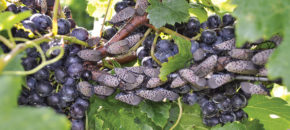Click to View | Download Report 7-24-18 Potato Disease Forecasting Report We will be tracking DSVs for Late blight development and calculating P-days for initiating the first early blight fungicide application. The first late blight fungicide application is recommended once 18 DSVs accumulate from green row. Green row typically occurs around the first week in May […]
Continue reading...Summer Patch on Hard Fescue
Hot weather in early July brought on some severe summer patch (root disease) symptoms in hard fescue. This disease on fine fescues hasn’t been as thoroughly studied as it has been on other grasses. So recommendations are based on knowledge learn… Read More »
Continue reading...Vegetable Disease Update – 7/23/18
Cucurbit downy mildew has been confirmed on cucumber in Warren County in northern NJ. This is the second report in the state this growing season. All cucumber growers should scout their fields on a regular basis and consider adding a downy mildew specific fungicide to their weekly maintenance sprays. CDM has been reported in cantaloupe in MD this past […]
Continue reading...Potato | Tomato Disease Forecast 7-20-18
Click to View | Download Report 7-20-18 Potato Disease Forecasting Report We will be tracking DSVs for Late blight development and calculating P-days for initiating the first early blight fungicide application. The first late blight fungicide application is recommended once 18 DSVs accumulate from green row. Green row typically occurs around the first week in May […]
Continue reading...Spotted Lanternfly in NJ

NEW PEST ALERT Spotted lanternfly (Lycorma deliculata, SLF) has been found in NJ. SLF is an invasive plant hopper species that could be very devastating to some NJ crops. Since its discovery in Pennsylvania in 2014, SLF has been placed under a state quarantine encompassing 13 Pennsylvania counties. Populations are also present in Virginia. SLF adults […]
Continue reading...IPM Update 7/18/18

Sweet Corn European corn borer (ECB) moth catches in black light traps are showing signs of increase now. This is an indication that the second flight is getting under way. Catches overall are still quite low however, and there will be no map in this edition. We expect to see increased feeding signs over the next two weeks, […]
Continue reading...